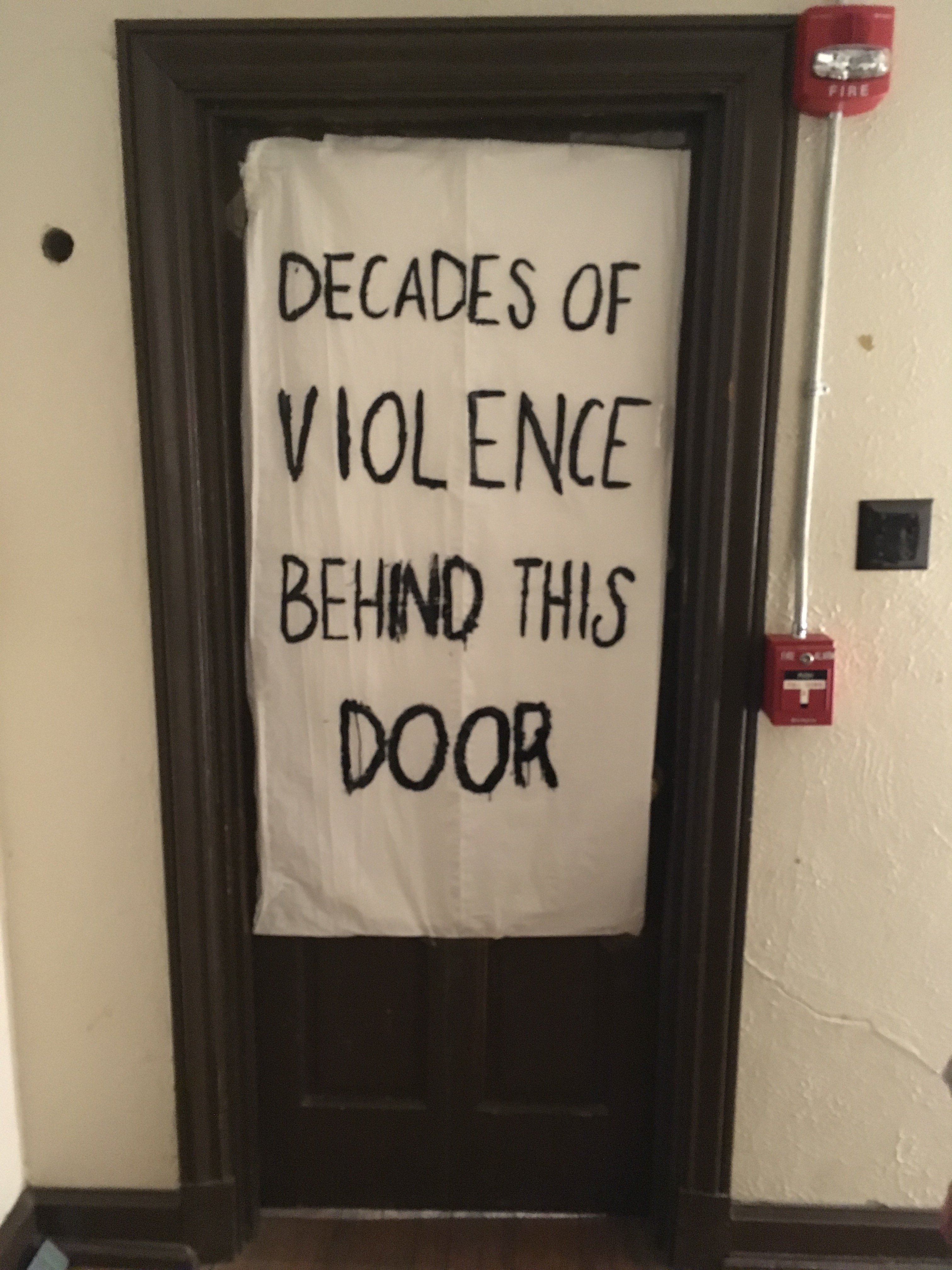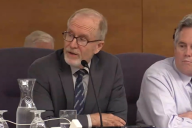You have /5 articles left.
Sign up for a free account or log in.

Grace Dumdaw
For three days, students at Swarthmore College, the elite institution known for its progressive politics, have occupied a picturesque stone house in the middle of campus, the quarters of one of the college’s two fraternities. Activists in the building say that it is the site of rampant sexual violence.
The students have refused to leave until college administrators meet their demands: disband the fraternities and take away the two campus buildings that they lease to the groups. The sit-in is part of a long battle around attempts to kick the Greek system off campus, but more broadly, it is about officials’ handling of rape cases.
The demonstration also comes after documents leaked to student journalists, purportedly chronicling years of bigotry and sexual assaults by one fraternity, Phi Psi, whose house the students have seized.
Even the existence of fraternities at Swarthmore might surprise outsiders. The academically demanding liberal arts college with Quaker roots, one of three institutions in the prominent Tri-College Consortium, does not seem like it would breed a strong Greek system. Two fraternities and a single sorority certainly is certainly not a robust setup, but accusations of sexual misconduct have followed the fraternities for many years.
Philadelphia Magazine wrote a large feature on Swarthmore in 2014, chronicling how its religious history and tradition of seeking consensus did not mesh well with administrators’ response to issues of sexual assault and Title IX of the Education Amendments of 1972, the federal gender antidiscrimination law. Swarthmore was also the subject of public and controversial Title IX complaints.
The most recent campaign against the fraternities was set off by a group of six or so students who said they saw social media postings by a fraternity member making light of sexual assaults and prejudice against LGBTQ people.
The students met this year and wrote down 20 or so stories of sexual violence they had either experienced or witnessed and set up a Tumblr -- a blog page -- advertising for other students to anonymously submit their own accounts, according to one student who participated in the project, Morgin Goldberg.
Goldberg, who reported being sexually assaulted by a fraternity member her first year at Swarthmore, said the website took off with more than 100 submissions not just from Swarthmore students, but also from students at the other two sister institutions in the consortium, Bryn Mawr College and Haverford College, who had attended fraternity parties at Swarthmore.
Shortly after the Tumblr anecdotes went public, the student newspapers at Swarthmore, The Phoenix and the left-leaning publication The Voices, published a trove of Phi Psi “meeting minutes” and other documents from 2012 to 2016. They detail fraternity members using illegal drugs and playing explicit drinking games and contain references to rape and derogatory terms for women, students of color and queer students. Sometimes the fraternity members would include photos of female students in the minutes.
“Keep up the hustle this weekend,” one member wrote in 2014. “I want to see chicks’ Olympic torches doused with your seed.”
Another wrote that a peer went around screaming that "he wanted to see black nipples."
Neither the college nor the fraternity has officially verified the veracity of the documents, but in a statement on Facebook, the fraternity members wrote, “We were made aware of two articles that are being released regarding unofficial internal communications. We wholeheartedly condemn the language of the 2013 and 2014 notes, as they are not representative of who we are today. All our current brothers were in high school and middle school at the time of these unofficial minutes, and none of us would have joined the organization had this been the standard when we arrived at Swarthmore.”
Phi Psi, whose chapter at Swarthmore is unaffiliated with the national fraternity, did not respond to a request for comment.
Mark Anskis, a campus spokesman, wrote in an email to Inside Higher Ed that the college has not vetted the documents’ authenticity, and directed a reporter to a statement by Jim Terhune, the dean of students, released April 18. Anskis did not respond to additional questions, such as the president’s position on banning fraternities.
“We first saw the material dating from 2013 to 2016 when it was published this morning,” Terhune said in the statement. “Although we are just beginning to fully review all that it includes, we share the outrage that has been expressed today. The kind of vulgar and offensive language used and behavior described in these reports contradicts the stated values of our community and is in direct violation of our policies.”
After the publications ran their stories on the documents, students pressed administrators to ban the fraternities but were unsuccessful, Goldberg said. She said that she has been trying for her nearly four years at Swarthmore, since her assault, to work with college leaders to oust the groups, but officials resisted those efforts and she was passed around from administrator to administrator with no answers.
Last spring, President Valerie Smith appointed a committee of students, professors and staffers, the Task Force on Student Social Events and Community Standards, that would eventually make recommendations on Greek life.
The group initially told Smith that the college should no longer lease houses to Phi Psi or the other fraternity, Delta Upsilon, a suggestion that Smith declined to follow. She said in September that “existing policies” could cover any misconduct that could arise out of the fraternities. Phi Psi came under fire in 2013 for a recruitment advertisement that featured naked women and was suspended in 2016 for violating the college's alcohol policy. It resumed campus parties in February 2018.
The task force will meet again this week and then deliver the recommendations and a report on Greek life, which the college will make public, Smith said to students.
In the interim, Smith has nixed all fraternity activities until an investigation into the documents is complete. The investigation is being led by an “external investigator,” Smith said in a statement Saturday, the day the sit-in began. Anskis did not answer questions about who the investigator is or how much the college paid for the consultation.
Swat Team, a group of students who help monitor events with alcohol and flag rule violations, refused to staff fraternity parties while their members "still hold position of power," the organization said in a statement.
"Swat Team leadership cannot, in good conscience, staff a fraternity party while these cycles of violence are ongoing. We call for Swarthmore College to immediately and permanently revoke the fraternity leases," the members wrote.
About 50 students, many affiliated with the student activist group Organizing for Survivors, started the sit-in on the house Saturday afternoon, but the number has since swelled to more than 100 students, who intend to remain there for the foreseeable future, Goldberg said. Swarthmore enrolls a little more than 1,600 students. The organizers also put together a petition asking for alumni to no longer donate until Swarthmore had removed the fraternities; the petition has more than 560 signatures from graduates.
 The activists have pitched tents both in the yard around the house and inside it. The building is not a traditional large-scale fraternity house -- its main floor is open and is akin to a dance floor for parties, and it has a basement and a single bedroom upstairs. The students leading the protest have hung banners that read, “This is our house” and “Decades of violence behind this door.”
The activists have pitched tents both in the yard around the house and inside it. The building is not a traditional large-scale fraternity house -- its main floor is open and is akin to a dance floor for parties, and it has a basement and a single bedroom upstairs. The students leading the protest have hung banners that read, “This is our house” and “Decades of violence behind this door.”
Only one fraternity member lives in the house, and the protesters worked with local police to allow him inside to retrieve his belongings, Goldberg said. Police, unaffiliated with the campus, have been called on students multiple times, but Anskis said no one has been arrested. Goldberg said that students told police they would not damage the property.
As a part of the students’ demands, the student would be asked to move out of the house, and it and its Delta Upsilon counterpart would be converted into buildings to be used by marginalized students, including those on campus who have been “victims” of the fraternities, Goldberg said.
Goldberg said that the fraternity members have historically been vicious toward students of color and gay students. Attitudes about the fraternities have shifted over the years, with more students becoming attuned to their misbehavior, Goldberg said, but she also added that the fraternities essentially offer the only form of social life with their parties.
“There has been a pattern of misconduct and a blatant refusal to hold them accountable,” Goldberg said of the fraternities.
Students with Organizing for Survivors have taken to confronting administrators, among them Smith and Nathan Miller, the associate dean for student life, whose office students attempted to barge into when he declined to answer their questions on the fraternities.








